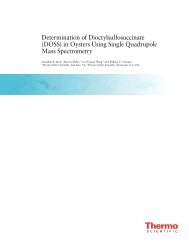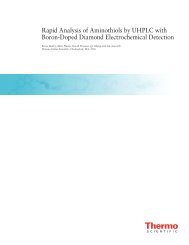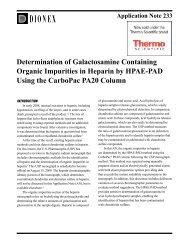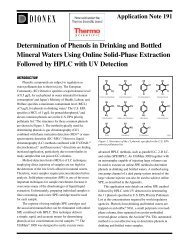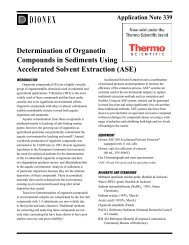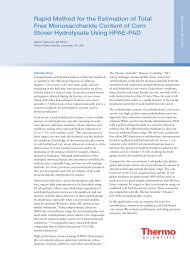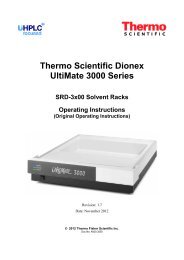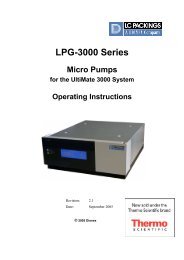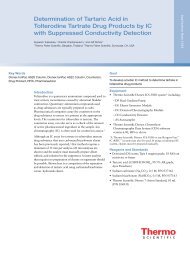MAbPac SCX-10 Column for Monoclonal Antibody Variant ... - Dionex
MAbPac SCX-10 Column for Monoclonal Antibody Variant ... - Dionex
MAbPac SCX-10 Column for Monoclonal Antibody Variant ... - Dionex
Create successful ePaper yourself
Turn your PDF publications into a flip-book with our unique Google optimized e-Paper software.
chromatography<br />
<strong>MAbPac</strong> <strong>SCX</strong>-<strong>10</strong> <strong>Column</strong> <strong>for</strong> <strong>Monoclonal</strong><br />
<strong>Antibody</strong> <strong>Variant</strong> Analysis and Characterization<br />
The Thermo Scientific <strong>MAbPac</strong> <strong>SCX</strong>-<strong>10</strong><br />
columns separate closely-related monoclonal<br />
antibody variants <strong>for</strong> characterization and<br />
quality control assessment.<br />
• Highest resolution of monoclonal<br />
antibody variants<br />
• Exceptionally high efficiency<br />
• Fast Analysis<br />
• Available in 3, 5 or <strong>10</strong> μm particle size<br />
• Excellent column-to-column and<br />
lot-to-lot reproducibility<br />
• Hydrophobic interactions essentially<br />
eliminated<br />
• Ideal <strong>for</strong> stability and QA/QC testing<br />
Part of Thermo Fisher Scientific<br />
High-Resolution, High-Efficiency<br />
Fast Analysis of <strong>Monoclonal</strong><br />
<strong>Antibody</strong> <strong>Variant</strong>s<br />
The <strong>MAbPac</strong> <strong>SCX</strong>-<strong>10</strong> column is a strong<br />
cation-exchange column designed specifically<br />
<strong>for</strong> the high-resolution, high-efficiency<br />
analysis of monoclonal antibodies and<br />
associated variants. The unique nonporous<br />
pellicular resin provides exceptionally high<br />
resolving power, permitting the separation of<br />
monoclonal antibody variants that differ by<br />
as little as one charged residue. Hydrophobic<br />
interactions with the resin are essentially<br />
eliminated, resulting in highly efficient peaks.<br />
While maintaining the same high<br />
resolution of longer <strong>MAbPac</strong> <strong>SCX</strong>-<strong>10</strong> column<br />
<strong>for</strong>mats, significantly faster analysis of<br />
monoclonal antibody variant samples can<br />
Product Specifications<br />
be achieved on <strong>MAbPac</strong> <strong>SCX</strong>-<strong>10</strong> columns of<br />
shorter <strong>for</strong>mat and smaller particle size. The<br />
<strong>MAbPac</strong> <strong>SCX</strong>-<strong>10</strong>, 3 and 5 µm particle size<br />
columns in a 4 × 50 mm <strong>for</strong>mat provide this<br />
exceptional capability.<br />
The <strong>MAbPac</strong> resin technology is the<br />
basis <strong>for</strong> the superior per<strong>for</strong>mance of<br />
monoclonal antibody variant analysis. The<br />
nonporous core particle provides high<br />
rates of mass transfer, which results in<br />
high-efficiency separations. A hydrophilic<br />
layer surrounds the polymeric beads,<br />
preventing hydrophobic interactions between<br />
proteins and the resin, also contributing to<br />
peaks with high efficiency. A proprietary<br />
grafted cation-exchange surface provides pH<br />
selectivity control, resulting in high-resolution<br />
separations.
Product Specifications<br />
2<br />
The 4 × 250 mm <strong>MAbPac</strong> <strong>SCX</strong>-<strong>10</strong> column<br />
is complementary to the industry-leading<br />
Thermo Scientific ProPac WCX-<strong>10</strong> column <strong>for</strong><br />
monoclonal antibody variant analysis, offering<br />
an alternative selectivity and providing higher<br />
resolution and efficiency <strong>for</strong> variant analysis<br />
of most monoclonal antibody samples. The<br />
columns are designed to address regulatory<br />
requirements <strong>for</strong> biopharmaceutical<br />
characterization. Consistent manufacturing<br />
processes ensure reproducibility in methods<br />
development and data analysis.<br />
Applications<br />
Use of the <strong>MAbPac</strong> <strong>SCX</strong>-<strong>10</strong> column has<br />
been demonstrated <strong>for</strong> analysis and<br />
characterization of monoclonal antibodies<br />
requiring high resolution and efficiency<br />
(Figure 1A).<br />
<strong>Monoclonal</strong> antibodies are currently<br />
developed by pharmaceutical and<br />
biotechnology companies <strong>for</strong> various<br />
therapeutic applications. <strong>Monoclonal</strong><br />
antibodies undergo several posttranslational<br />
modifications including<br />
oxidations, deamidations, glycosylation,<br />
incomplete C-terminal processing, and<br />
others. These modifications cause antibody<br />
microheterogeneity or variants. Variations<br />
in a monoclonal antibody’s composition<br />
can impact its activity and stability as<br />
a biotherapeutic. Monitoring stability<br />
of therapeutic monoclonal antibodies is<br />
regarded as essential <strong>for</strong> demonstrating<br />
safety and efficacy of a monoclonal antibody<br />
drug, and is expected by the FDA and other<br />
regulatory agencies. With its ability to<br />
characterize monoclonal heterogeneity,<br />
the <strong>MAbPac</strong> <strong>SCX</strong>-<strong>10</strong> column can be used<br />
<strong>for</strong> stability testing and other monoclonal<br />
antibody applications by providing<br />
exceptionally high efficiencies and high<br />
resolution of monoclonal antibody variants.<br />
Acidic and Basic <strong>Variant</strong> Analysis<br />
One of the most important and common<br />
analyses of monoclonal antibody heterogeneity<br />
is the monitoring and determination<br />
of acidic and basic variants. The <strong>MAbPac</strong><br />
<strong>SCX</strong>-<strong>10</strong> column provides excellent peak<br />
efficiencies and exceptionally high resolution<br />
<strong>for</strong> acidic and basic variant analysis of monoclonal<br />
antibodies. Figure 1B shows the high<br />
resolution separation of monoclonal antibody<br />
acidic and basic variants, and the C-terminal<br />
lysine variants. Five acidic and eight basic<br />
variant peaks are resolved. Another example<br />
is shown in Figure 1C, which displays four<br />
acidic and seven basic monoclonal antibody<br />
variant peaks resolved using the <strong>MAbPac</strong><br />
<strong>SCX</strong>-<strong>10</strong> column.<br />
35 A<br />
mAU<br />
0<br />
<strong>Column</strong>: <strong>MAbPac</strong> <strong>SCX</strong>-<strong>10</strong> (4 × 250 mm)<br />
Eluents: A. 20 mM MES (pH 5.6) + 60 mM NaCl<br />
B. 20 mM MES (pH 5.6) + 300 mM NaCl<br />
Gradient: 5–55% B in 60 min, gradient<br />
slope constant<br />
Flow Rate: 1 mL/min<br />
Inj. Volume: <strong>10</strong> µL<br />
Detection: UV at 280 nm<br />
Sample: MAb A, 5 mg/mL<br />
-5<br />
0 <strong>10</strong> 20 30 40 50 60 67<br />
Minutes<br />
mAU<br />
0<br />
50<br />
mAU<br />
0<br />
B<br />
C<br />
1<br />
2<br />
2 3<br />
1<br />
3<br />
4<br />
5<br />
4<br />
5 6 78<br />
6<br />
7<br />
9<br />
8<br />
<strong>10</strong><br />
9<br />
<strong>10</strong><br />
11 12<br />
13 14<br />
15<br />
16<br />
17 18<br />
<strong>Column</strong>: <strong>MAbPac</strong> <strong>SCX</strong>-<strong>10</strong> (4 × 250 mm)<br />
Eluents: A. 20 mM MES (pH 5.6) + 60 mM NaCl<br />
B. 20 mM MES (pH 5.6) + 300 mM NaCl<br />
Gradient: 15–36% B in 50 min<br />
Flow Rate: 1 mL/min<br />
Temperature: 30 °C<br />
Inj. Volume: <strong>10</strong> µL<br />
Detection: UV at 280 nm<br />
Sample: MAb B, 5 mg/mL<br />
Peaks 1–5: Acidic variants<br />
Peaks 6, 8, 11: C-Terminal Lys variants<br />
Peaks 12–17: Basic variants<br />
0 <strong>10</strong> 20 30<br />
Minutes<br />
40 50 58<br />
1 2<br />
4<br />
3<br />
5<br />
6<br />
11<br />
9<br />
8<br />
7<br />
Minutes<br />
12 13 14 15 16 17<br />
<strong>Column</strong>: <strong>MAbPac</strong> <strong>SCX</strong>-<strong>10</strong> (4 × 250 mm)<br />
Eluents: A. 20 mM Tris (pH 7.3)<br />
B. 0.5 mM NaCl in Eluent A<br />
Gradient: 1–25% B in 60 min<br />
Flow Rates: 1 mL/min<br />
Inj. Volume: <strong>10</strong> µL<br />
Detection: UV at 280 nm<br />
Sample: MAb C, 5 mg/mL<br />
<strong>10</strong><br />
11 12<br />
-5<br />
15 18 20 22 24 26 28 30 32 34 36 38 40<br />
Figure 1. The <strong>MAbPac</strong> <strong>SCX</strong>-<strong>10</strong> column provides excellent peak efficiencies and exceptional resolution<br />
of monoclonal antibody variants. A) MAb A separation showing excellent peak efficiencies; B) Separation<br />
of MAb B acidic, basic and C-terminal lysine variants; C) MAb C variant separation.
C-Terminal Lysine <strong>Variant</strong> Analysis<br />
During the development and the production<br />
of therapeutic monoclonal antibodies,<br />
characterization of structural variants is a<br />
critical challenge. C-terminal processing<br />
of lysine residues on the heavy chain of<br />
monoclonal antibodies is a common structural<br />
variation that demands analysis. Incomplete<br />
monoclonal antibody processing results<br />
in charge heterogeneity, which is readily<br />
identified using the <strong>MAbPac</strong> <strong>SCX</strong>-<strong>10</strong> column.<br />
Figure 2 illustrates this with the baseline<br />
resolution of C-terminal lysine variants, and<br />
many other acidic and basic variants of a<br />
monoclonal antibody sample. After treatment<br />
with carboxypeptidase B, only one major<br />
peak remains, verifying that the three major<br />
peaks were due to variations in C-terminal<br />
lysine presence.<br />
Analysis of MAb Fragments<br />
After Digestion with Papain<br />
and Carboxypeptidase<br />
The <strong>MAbPac</strong> <strong>SCX</strong>-<strong>10</strong> column can<br />
successfully provide high resolution and<br />
efficiency <strong>for</strong> monoclonal antibodies<br />
that have been treated with papain and<br />
carboxypeptidase enzymes. <strong>Monoclonal</strong><br />
antibodies treated with papain enzyme are<br />
separated into their Fab and Fc fragments.<br />
Figure 3 shows the well resolved Fab and<br />
Fc fragments after a monoclonal antibody<br />
and its variants are treated with papain<br />
alone, or with papain and carboxypeptidase<br />
together. The expected acidic, C-terminal<br />
lysine truncation-containing Fc fragments<br />
and Fab fragment peaks are determined<br />
and well resolved. Lysine truncation variant<br />
peaks collapse into one main peak with the<br />
carboxypeptidase treatment.<br />
27.5<br />
mAU<br />
0<br />
<strong>Column</strong>: <strong>MAbPac</strong> <strong>SCX</strong>-<strong>10</strong> (4 × 250 mm)<br />
Eluents: A. 20 mM MES (pH 5.6) + 60 mM NaCl<br />
B. 20 mM MES (pH 5.6) + 300 mM NaCl<br />
Gradient: 15–36% B in 50 min<br />
Flow Rate: 1 mL/min<br />
Temperature: 30 °C<br />
Inj. Volume: 5 µL<br />
Detection: UV at 280 nm<br />
6<br />
4 5<br />
2<br />
1<br />
3<br />
4 5<br />
1 2 3<br />
6<br />
7<br />
Samples: 1. MAb B, 900 µg in <strong>10</strong>0 µL<br />
(no carboxypeptidase)<br />
2. MAb B, 900 µg in <strong>10</strong>0 µL +<br />
carboxypeptidase, 50 µg,<br />
incubation at 37 °C <strong>for</strong> 3 h<br />
Both<br />
Chromatograms: Peaks 1–5: Acidic variants<br />
Sample 1: Peaks 6–8: C-Terminal lysine<br />
truncation variants of main peak<br />
Peaks 9–11: C-Terminal lysine<br />
truncation variants of minor<br />
variant peak<br />
Sample 2: Peak 6 results from peaks 6, 7,<br />
and 8 after CBP treatment<br />
Peak 9 results from peaks 9, <strong>10</strong>,<br />
and 11 after CBP treatment<br />
0 <strong>10</strong> 20 30<br />
Minutes<br />
40 50 58<br />
Figure 2. Baseline resolution of C-terminal lysine variants of a monoclonal antibody sample. A second<br />
chromatogram verifies that the three major peaks are due to variations in C-terminal content: after the<br />
treatment with carboxypeptidase B, only one major peak remains.<br />
50<br />
mAU<br />
<strong>Column</strong>: <strong>MAbPac</strong> <strong>SCX</strong>-<strong>10</strong> (4 × 250 mm)<br />
Eluents: A. 20 mM MES (pH 5.6) + 60 mM NaCl<br />
B. 20 mM MES (pH 5.6) + 300 mM NaCl<br />
Gradient: 1–35% B in 50 min<br />
Flow Rate: 1 mL/min<br />
Temperature: 30 °C<br />
Inj. Volume: 5 µL<br />
1<br />
5<br />
8<br />
11<br />
<strong>10</strong><br />
2<br />
2<br />
1<br />
7<br />
1<br />
0<br />
0 <strong>10</strong> 20 30 40 50 58<br />
Minutes<br />
27565<br />
4 3<br />
5<br />
6 7<br />
8 9 14<br />
2 3 4<br />
6<br />
8 9 <strong>10</strong> 11<br />
13<br />
12<br />
9<br />
9<br />
<strong>10</strong><br />
11<br />
2<br />
1<br />
27564<br />
Detection: UV at 280 nm<br />
Samples: 1. MAb B, 3 mg in 300 µL + papain,<br />
<strong>10</strong>0 µg<br />
2. MAb B, 3 mg in 300 µL + papain,<br />
<strong>10</strong>0 µg + carboxypeptidase,<br />
50 µg, incubation at 37 °C <strong>for</strong> 3 h<br />
Both<br />
Chromatograms: Peaks 1–4: Acidic variants<br />
Sample 1: Peaks 5–7: C-Terminal lysine<br />
truncation variants of<br />
papain-treated sample<br />
Peaks 13, 14: Fab peaks<br />
Sample 2: Peak 5 results from Sample 1<br />
peaks 5, 6, and 7 after<br />
CBP treatment<br />
Peaks <strong>10</strong>, 11: Fab peaks<br />
Figure 3. High resolution analysis of monoclonal antibody fragments after treatment with papain or<br />
papain and carboxypeptidase enzymes. The expected acidic, C-terminal lysine vatiants containing Fc,<br />
and Fab fragment peaks are well resolved.<br />
3
Product Specifications<br />
4<br />
Optimization<br />
The <strong>MAbPac</strong> <strong>SCX</strong>-<strong>10</strong> resin technology<br />
provides the ability to optimize highresolution<br />
monoclonal antibody variant<br />
separations. High-resolution separations<br />
are achieved through the optimization of<br />
different buffers, gradient changes, and pH<br />
selectivity control. <strong>Monoclonal</strong> antibody<br />
chromatographic separations can be<br />
achieved and optimized using gradients<br />
based on changing salt or pH conditions.<br />
Figure 4 demonstrates a high-resolution<br />
monoclonal antibody variant separation using<br />
a pH gradient.<br />
The use of a pH gradient <strong>for</strong> the analysis<br />
of monoclonal antibody samples on <strong>MAbPac</strong><br />
<strong>SCX</strong>-<strong>10</strong> columns offers some key advantages.<br />
A single pH method can be used <strong>for</strong> the<br />
analysis of monoclonal antibody samples with<br />
varying iso-electric points. Also, pH gradients<br />
can provide high resolution separations on<br />
short length 50 mm columns thus providing<br />
short separation times or fast analysis.<br />
These attributes provide fast high-throughput<br />
analysis of multiproduct monoclonal antibody<br />
samples. Figure 5 shows the use of a pH<br />
gradient on a 4 × 50 mm <strong>MAbPac</strong> <strong>SCX</strong>-<strong>10</strong>,<br />
3 µm column <strong>for</strong> the fast high resolution<br />
analysis of a monoclonal antibody variant<br />
sample which takes only 15 minutes.<br />
mAU<br />
60 <strong>Column</strong>: <strong>MAbPac</strong> <strong>SCX</strong>-<strong>10</strong> (4 × 250 mm)<br />
Flow Rate: 1 mL/min<br />
Eluents: A. 2.4 mM Tris + 1.5 mM imidazole<br />
Temperature: 30 °C<br />
+ 11.6 mM piperazine (pH 6.0)<br />
Inj. Volume: <strong>10</strong> µg<br />
A. 2.4 mM Tris + 1.5 mM imidazole<br />
Detection: UV at 280 nm<br />
+ 11.6 mM piperazine (pH 9.5)<br />
Sample: MAb D, 5 mg/mL<br />
Gradient: 0–<strong>10</strong>0% B in 60 min<br />
0<br />
-<strong>10</strong><br />
<strong>10</strong> 20 30<br />
Minutes<br />
40 45<br />
27651<br />
Figure 4. With the use of a pH gradient, the <strong>MAbPac</strong> <strong>SCX</strong>-<strong>10</strong> column provides high resolution of<br />
monoclonal antibody variants.<br />
<strong>10</strong><br />
mAU<br />
0<br />
3<br />
2<br />
1<br />
4<br />
5<br />
0.0 2.0 4.0 6.0<br />
Minutes<br />
8.0 <strong>10</strong>.0 12.8<br />
6<br />
7<br />
8<br />
<strong>Column</strong>: <strong>MAbPac</strong> <strong>SCX</strong>-<strong>10</strong>, 3 um, 4 × 50 mm<br />
Eluents: A) 4.8 mM Tris + 3 mM imidazole+ 23.2 mM piperazine,<br />
pH 6.0<br />
B) 4.8 mM Tris + 3 mM imidazole+ 23.2 mM piperazine,<br />
pH <strong>10</strong>.5<br />
Gradients: 49–56% B in <strong>10</strong> min<br />
Flow Rate: 0.6 mL/min<br />
Temperature: 30 °C<br />
Sample: MAb, 1 mg/mL<br />
Inj. Volume: 15 µL<br />
Detection: UV at 280 nm<br />
Peaks: 1–4 : Acidic variants<br />
5, 6, 8: C-Terminal lys truncation variants<br />
9<br />
9-11 :<br />
<strong>10</strong><br />
11<br />
Basic variants<br />
Figure 5. Fast pH-gradient elution: MAb separation using 3 µm MAb <strong>SCX</strong>-<strong>10</strong> columns.<br />
50<br />
A<br />
5<br />
6<br />
mAU<br />
9<br />
3<br />
4<br />
2<br />
1<br />
7<br />
8 12<br />
<strong>10</strong> 11 13 14<br />
-5<br />
0 2 4 6 8 <strong>10</strong><br />
30<br />
mAU<br />
B<br />
6<br />
3 4<br />
5<br />
8<br />
11<br />
9<br />
1<br />
<strong>10</strong><br />
12 13 14<br />
2<br />
7<br />
15 16<br />
-5<br />
0 5 <strong>10</strong> 15<br />
Minutes<br />
28738<br />
<strong>Column</strong>: <strong>MAbPac</strong> ® <strong>SCX</strong>-<strong>10</strong>, 3 um, 4 × 50 mm<br />
Eluents: A) 20 mM MES + 60 mM NaCI, pH 5.6<br />
B) 20 mM MES + 300 mM NaCI, pH 5.6<br />
Gradients: A) 20–35% B in 5 min<br />
B) 20–35% B in <strong>10</strong> min<br />
Flow Rate: 0.6 mL/min<br />
Temperature: 30 °C<br />
Sample: MAb, 1 mg/mL<br />
Inj. Volume: 15 µL<br />
Detection: UV at 280 nm<br />
Peaks: A: 5 min Gradient<br />
1–4 : Acidic variants<br />
5, 6, 9: C-Terminal lys variants<br />
<strong>10</strong>–14 : Basic variants<br />
B: <strong>10</strong> min Gradient<br />
1–5: Acidic variants<br />
6, 8, 11: C-Termianl lys variants<br />
12–16: Basic variants<br />
Figure 6. Fast salt-gradient elution: MAb separations using 3 µm MAb <strong>SCX</strong>-<strong>10</strong> columns.<br />
28737
Fast MAB Characterization<br />
Analysis<br />
Fast high-resolution analysis of monoclonal<br />
antibody samples with exceptionally short<br />
separation run times can be achieved on<br />
<strong>MAbPac</strong> <strong>SCX</strong>-<strong>10</strong> columns. This can be<br />
accomplished through the use of columns<br />
with 3 or 5 µm particle sizes and a column<br />
length of 50 mm. Using a 4 × 50 mm, 3 µm<br />
<strong>MAbPac</strong> <strong>SCX</strong>-<strong>10</strong> column Figures 5 and 6<br />
show high resolution monoclonal antibody<br />
variant separations with exceptionally short<br />
separation times which were accomplished<br />
with pH and salt gradients, respectively.<br />
Figure 7 demonstrates the 5 µm <strong>MAbPac</strong><br />
<strong>SCX</strong>-<strong>10</strong>, 4 × 50 mm column providing fast,<br />
high resolution monoclonal antibody variant<br />
analysis using MES-based salt gradients.<br />
Panel A shows a 5-minute gradient and<br />
Panel B shows a <strong>10</strong>-minute gradient.<br />
High resolution is achieved with a longer,<br />
shallow gradient.<br />
The 3 and 5 µm, 4 × 50 mm <strong>MAbPac</strong><br />
<strong>SCX</strong>-<strong>10</strong> columns provide the same high<br />
resolution as the <strong>MAbPac</strong> <strong>SCX</strong>-<strong>10</strong>,<br />
<strong>10</strong> µm, 4 × 250 mm columns but with<br />
significantly faster analysis time. Figure 8<br />
shows the 3 µm <strong>MAbPac</strong> <strong>SCX</strong>-<strong>10</strong>, 4 × 50 mm<br />
column providing significantly faster analysis<br />
while maintaining the comparable high<br />
resolution <strong>for</strong> monoclonal antibody variant<br />
analysis as the <strong>MAbPac</strong> <strong>SCX</strong>-<strong>10</strong>, <strong>10</strong> µm, and<br />
ProPac WCX-<strong>10</strong>, 4 × 250 mm columns.<br />
55<br />
1<br />
-5<br />
0 1 2 3 4 5 6 7 8 9 <strong>10</strong><br />
23<br />
6<br />
mAU<br />
8<br />
4<br />
7 11<br />
9 <strong>10</strong> 1213<br />
60<br />
A<br />
B<br />
5<br />
5<br />
0<br />
-<strong>10</strong><br />
3<br />
0 2 4 6 8 <strong>10</strong> 12 14 16 18 20<br />
4<br />
6<br />
<strong>10</strong> 11 1 9 12<br />
2<br />
mAU<br />
8<br />
7<br />
13<br />
Minutes<br />
<strong>Column</strong>s: <strong>MAbPac</strong> <strong>SCX</strong>-<strong>10</strong>,<br />
5 µm, 4 × 50 mm<br />
Eluents: A: 20 mM MES + 60 mM NaCI,<br />
pH 5.6<br />
B: 20 mM MES + 300 mM NaCl,<br />
pH 5.6<br />
Gradients: A) 18–33% B in 5 min<br />
B) 18–33% B in <strong>10</strong> min<br />
Flow Rate: 1 mL/min<br />
Temperature: 30 °C<br />
Sample: MAb, 5 mg/mL<br />
Inj. Volume: 15 µL<br />
Detection: UV at 280 nm<br />
Peaks: 1–4. Acidic variants<br />
5, 6, 8. C-Terminal lysine variants<br />
9-13. Other basic variants<br />
Figure 7. The 5 µm <strong>MAbPac</strong> <strong>SCX</strong>-<strong>10</strong>, 4 × 50 mm column provides fast, high resolution monoclonal<br />
antibody variant analysis.<br />
18<br />
mAU<br />
16<br />
mAU<br />
30<br />
mAU<br />
A<br />
B<br />
0 <strong>10</strong> 20 30 40 50 58<br />
C<br />
6<br />
6<br />
8<br />
345 1<br />
11<br />
9<br />
<strong>10</strong><br />
1213<br />
14<br />
2<br />
7<br />
15 16<br />
6<br />
345 8<br />
11<br />
121314<br />
9<br />
1<br />
<strong>10</strong> 2<br />
7<br />
15 16<br />
8<br />
11<br />
0<br />
3<br />
-5<br />
0 5<br />
Minutes<br />
<strong>10</strong> 15<br />
45 9<br />
<strong>10</strong><br />
1 12 13 14<br />
2<br />
7<br />
15 16<br />
29149<br />
<strong>Column</strong>s: A) ProPac WCX-<strong>10</strong>, 4 × 250 mm<br />
B) <strong>MAbPac</strong> <strong>SCX</strong>-<strong>10</strong>, (<strong>10</strong> µm) 4 × 250 mm<br />
C) <strong>MAbPac</strong> <strong>SCX</strong>, 3 µm, 4 × 50 mm<br />
Eluents: A: 20 mM MES +60 mM NaCl, pH 5.6<br />
B: 20 mM MES + 300 mM NaCl, pH 5.6<br />
Gradients: A) 25–46.44% B in 50 min<br />
B) 15–36.44% B in 50 min<br />
C) 20–35% B in <strong>10</strong> min<br />
Flow Rate: 1 mL/min (0.6 mL/min <strong>for</strong> C)<br />
Inj. Volume: A and B: 5 µL (50 µg)<br />
C: 15 µL (15 µg)<br />
Temp: 30 °C<br />
Detection: 280 nm<br />
Sample: MAb; A and B) <strong>10</strong> mg/mL<br />
C) 1 mg/mL<br />
Peaks: 1–5: Acidic variants;<br />
6,8,11: Lysine truncation variants<br />
12–16: Basic variants<br />
Figure 8. The 3 µm <strong>MAbPac</strong> <strong>SCX</strong>-<strong>10</strong>, 4 × 50 mm column provides significantly faster analysis while<br />
maintaining the similar high resolution as that obtained using the <strong>MAbPac</strong> <strong>SCX</strong>-<strong>10</strong> and ProPac WCX-<strong>10</strong>,<br />
4 × 250 mm columns.<br />
29147<br />
5
Product Specifications<br />
6<br />
Reproducibility<br />
The <strong>MAbPac</strong> <strong>SCX</strong>-<strong>10</strong> column’s reproducible<br />
manufacturing process eliminates column<br />
and lot variability as a concern in methods<br />
development and data analysis. <strong>MAbPac</strong><br />
columns are manufactured and tested under<br />
the strictest specifications resulting in<br />
unmatched column and lot reproducibility.<br />
Figure 9 shows column reproducibility with<br />
virtually no change in per<strong>for</strong>mance <strong>for</strong> four<br />
different columns.<br />
In addition, Figure <strong>10</strong> demonstrates<br />
<strong>MAbPac</strong> <strong>SCX</strong>-<strong>10</strong> lot reproducibility with<br />
virtually no change in per<strong>for</strong>mance <strong>for</strong> three<br />
different lots.<br />
0.0084<br />
AU<br />
0.00549<br />
AU<br />
–0.00027<br />
0.00492<br />
AU<br />
–0.00006<br />
0.00511<br />
AU<br />
4<br />
3<br />
2<br />
1<br />
–0.0043<br />
0 <strong>10</strong> 20 30 40 50 56<br />
Minutes<br />
27511<br />
<strong>Column</strong>: <strong>MAbPac</strong> <strong>SCX</strong>-<strong>10</strong>, 4 × 250 mm<br />
Eluents: A) 20 mM MES, 60 mM NaCl, pH = 5.5<br />
B) 20 mM MES, 300 mM NaCl, pH = 5.5<br />
A<br />
B<br />
C<br />
Time (min) %A %B<br />
2.0 85 15<br />
52.0 63.56 36.44<br />
1<br />
1<br />
1<br />
<strong>Column</strong>: <strong>MAbPac</strong> <strong>SCX</strong>-<strong>10</strong> (4 × 250 mm)<br />
Eluents: A. 20 mM MES (pH 5.6) + 60 mM NaCl<br />
B. 20 mM MES (pH 5.6) + 300 mM NaCl<br />
Gradient: 15–36% B in 50 min<br />
Flow Rate: 1 mL/min<br />
Temperature: 30 °C<br />
Inj. Volume: <strong>10</strong> µL<br />
Detection: UV at 280 nm<br />
Sample: MAb B, 5 mg/mL<br />
Figure 9. Demonstration of column-to-column reproducibility with virtually no change in per<strong>for</strong>mance <strong>for</strong><br />
four different <strong>MAbPac</strong> <strong>SCX</strong>-<strong>10</strong> columns tested.<br />
–0.00017<br />
–0.1 4.0 8.0 12.0 16.0 20.0 24.0 28.0 32.0 36.0 40.0 44.0 48.0 53.9<br />
Minutes<br />
275<strong>10</strong><br />
2<br />
2<br />
2<br />
3<br />
3<br />
3<br />
Flow Rate: 1.0 mL/min<br />
Inj. Volume: <strong>10</strong> µL<br />
Detection: UV at 280 nm<br />
Sample: MAb 5 mg/mL<br />
Figure <strong>10</strong>. Excellent lot-to-lot reproducibility of the <strong>MAbPac</strong> <strong>SCX</strong>-<strong>10</strong> column is shown. <strong>Column</strong>s from each<br />
of the three different lots (A, B, C) were used <strong>for</strong> MAb analysis.
Product Specifications<br />
www.thermoscientific.com<br />
<strong>Column</strong> Construction PEEK <br />
Bead Size 3 µm, 5 µm, <strong>10</strong> µm<br />
SPECIFICATIONS<br />
Substrate Highly crosslinked DVB media<br />
Pellicular Layer Proprietary hydrophilic<br />
Functional Group Sulfonic<br />
Pressure Limit 7000 psi <strong>for</strong> 3 µm, 3000 psi <strong>for</strong> <strong>10</strong> µm<br />
Temperature Range Ambient to 60 °C<br />
pH Range 2–12<br />
Dynamic Loading Capacity Up to <strong>10</strong>0 µg, depending on the monoclonal antibody sample (<strong>10</strong> µm, 4 × 250 mm)<br />
Typical Buffers MES, or other Good’s buffers, Tris, phosphate<br />
Solvents 50% acetonitrile if needed <strong>for</strong> cleaning<br />
Detergent Compatibility Nonionic, anionic, or zwitterionic detergents<br />
ORDERING INFORMATION<br />
To order in the U.S., call 1-800-346-6390, or contact the Thermo Fisher Scientific office nearest you. Outside the U.S., order through your<br />
local Thermo Fisher Scientific office or distributor. Refer to the following part numbers.<br />
<strong>MAbPac</strong> <strong>SCX</strong>-<strong>10</strong> Analytical <strong>Column</strong> Part Number<br />
<strong>MAbPac</strong> <strong>SCX</strong>-<strong>10</strong>, 3 µm, Analytical <strong>Column</strong> (4 × 50 mm) 077907<br />
<strong>MAbPac</strong> <strong>SCX</strong>-<strong>10</strong>, 5 µm, Analytical <strong>Column</strong> (4 × 50 mm) 078656<br />
<strong>MAbPac</strong> <strong>SCX</strong>-<strong>10</strong>, 5 µm, Analytical <strong>Column</strong> (4 × 250 mm) 078655<br />
<strong>MAbPac</strong> <strong>SCX</strong>-<strong>10</strong>, <strong>10</strong> µm, Analytical <strong>Column</strong> (4 × 150 mm) 075602<br />
<strong>MAbPac</strong> <strong>SCX</strong>-<strong>10</strong>, <strong>10</strong> µm, Analytical <strong>Column</strong> (4 × 250 mm) 074625<br />
<strong>MAbPac</strong> <strong>SCX</strong>-<strong>10</strong>, <strong>10</strong> µm, Analytical <strong>Column</strong> <strong>SCX</strong>-<strong>10</strong>HT (4 × 50 mm) 075603<br />
<strong>MAbPac</strong> <strong>SCX</strong>-<strong>10</strong>, <strong>10</strong> µm, Analytical <strong>Column</strong> <strong>SCX</strong>-<strong>10</strong> (2 × 250 mm) 075604<br />
Lot Select <strong>Column</strong> Set Part Number<br />
Lot Select <strong>Column</strong> Set—Three columns from one resin lot (4 × 250 mm) SP6864<br />
Lot Select <strong>Column</strong> Set—One column from each of three resin lots (4 × 250 mm) SP6865<br />
<strong>MAbPac</strong> <strong>SCX</strong>-<strong>10</strong> Semipreparative <strong>Column</strong> Part Number<br />
<strong>MAbPac</strong> <strong>SCX</strong>-<strong>10</strong>, <strong>10</strong> µm, Semipreparative <strong>Column</strong> (9 × 250 mm) SP6866<br />
<strong>MAbPac</strong> <strong>SCX</strong>-<strong>10</strong> Guard <strong>Column</strong> Part Number<br />
<strong>MAbPac</strong> <strong>SCX</strong>-<strong>10</strong> Guard <strong>Column</strong> (2 × 50 mm) 075749<br />
<strong>MAbPac</strong> <strong>SCX</strong>-<strong>10</strong> Guard <strong>Column</strong> (4 × 50 mm) 074631<br />
© 2012 Thermo Fisher Scientific Inc. PEEK is a trademark of Victrex PLC. All rights reserved. All other trademarks are the property of Thermo Fisher Scientific<br />
Inc. and its subsidiaries. Specifications, terms and pricing are subject to change. Not all products are available in all countries. Please consult your local sales<br />
representative <strong>for</strong> details.<br />
<strong>Dionex</strong> Products: 1228 Titan Way, PO Box 3603, Sunnyvale, CA 94088-3603, (408) 737-0700<br />
North America: U.S./Canada (847) 295-7500<br />
South America: Brazil (55) 11 3731 5140<br />
Europe: Austria (43) 616 51 25, Benelux (31) 20 683 9768 (32) 3 353 4294, Denmark (45) 36 36 90 90, France (33) 1 39 30 01 <strong>10</strong>, Germany (49) 6126 991 0,<br />
Ireland (353) 1 644 0064, Italy (39) 02 51 62 1267, Sweden (46) 8 473 3380, Switzerland (41) 62 205 9966, United Kingdom (44) 1276 691722<br />
Asia Pacific: Australia (61) 2 9420 5233, China (852) 2428 3282, India (91) 22 2764 2735, Japan (81) 6 6885 1213,<br />
Korea (82) 2 2653 2580, Singapore (65) 6289 1190, Taiwan (886) 2 8751 6655<br />
Thermo Scientific <strong>Dionex</strong> products are<br />
designed, developed, and manufactured<br />
under an ISO 9001 Quality System.<br />
LPN 2567-06 01/12




